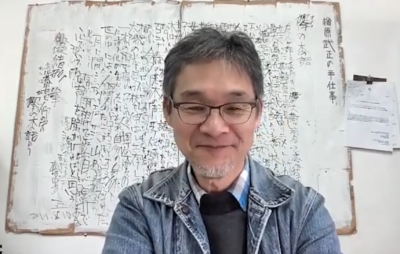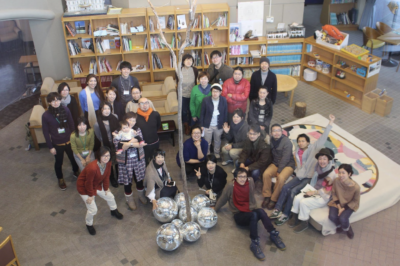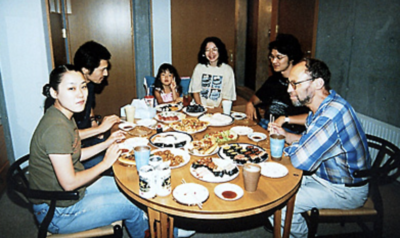Life of Art and Artists
December 5, 2023
Text by Midori Yamanaka with Hisashi Shibata
“It’s art. I’ve come to realize it’s not just the creations of artists, but also the remnants left by those around them. That is when I realized the importance of archives.“
– Hisashi Shibata
(これがアートなんだぁ…と。作品とは、アーティストだけでなく、周囲の人が残したものでもあるのだ、と。その時、本当の意味でアーカイブの大切さがわかったんです。-柴田尚)
NPO S-AIRは、1999年より札幌でアーティストインレジデンスを行っています。私がアートアンドソーシャルプラクティスの道を歩むきっかけのひとつが、このS-AIRでした。
Since 1999, S-AIR has been running artist-in-residence programs in Sapporo, Japan. S-AIR was one of the reasons I decided to pursue the path of art and social practice.
私は以前、S-AIRが主催するイベント「AIR CAMP」で、ベトナム、カンボジア、そしてフィリピンからの招聘アーティストのプレゼンテーションとアーティストトークの通訳を担当させてもらいました。そこは国際交流の場であり、発見と学びの場でした。私のとっては、さまざまなアーティストのあり方が存在することを知った場所でもあります。
At an event called “AIR CAMP,” hosted by S-AIR, I was in charge of interpreting presentations and artist talks by invited artists from Vietnam, Cambodia, and the Philippines. It was a place of international cultural exchange, discovery and learning. For me, it was also the place where I learned that there are many different ways of being an artist.
今回は、S-AIRの創設者で代表の柴田尚氏に、アートを職業にすること、そしてアーティストインレジデンスについて伺いました。
For this article, I interviewed Nao Shibata, the founder and representative of S-AIR, about being a professional in art and artist residencies.

Midori Yamanaka: アーティストを職業と考えると、他のフィールドよりもさまざまな挑戦が多いように思います。柴田さんご自身はどのようにアートを仕事にされて来たんですか。
When you consider being an artist as a profession, I think there are more challenges than in other fields. Mr. Shibata, how did you get into art as a career?
Hisashi Shibata: 僕自身、仕事って何なのかというのを、ずっと考えています。
I’ve been thinking about what work is all about.
中1の時に、父親が癌になりました。父は、中学校しか出てないペンキ塗装工のペンキ屋でした。母親は、文字を見るのも嫌い。両親とも学のない家庭に生まれ育ちました。で、大黒柱の親父が癌になったんで、もう高校進学も諦めて、すぐ就職してくれという感じでした。ブルーカラーの土地柄だったので、それも普通でした。
My father got cancer when I was in 6th grade. My father was a painter who only attended junior high school. My mother doesn’t even like looking at letters. I was born and raised in a family where both my parents were not highly educated. Then, my father got cancer, so my family told me to give up on going to high school and get a job right away. I came from a blue-collar area, so that was normal.
そこから、芸術の大学の先生になるってのは、もうものすごいウルトラCなんですよ。
Coming from such a situation, becoming a professor at an art university is already a huge career advancement.
Midori: 本当ですね…
I can see that.
Hisashi: そんな状況だったので、美術大学を志すところから、もう大げんかでした。「お前は何をしようとしてるのか」と。親の貯金通帳を叩きつけられて、「これだよ?どうやって生きていくの?」と言われました。
Because of that situation, I had a big fight about wanting to go to art school. My parents said, “I don’t understand what you are trying to do,” while their bank statement was slapped on me. They asked “This is what we have. How are we going to survive?”
それで僕は、二浪までしたんですよ。
So I spent a good two years before going on to higher education.
Midori: すごいガッツ!
How determined you were!
Hisashi: 何度も諦めそうになったけれど、何故か学校の先生が説得しに来たり、親戚が親を説得しに来たり助けが入った。
I almost gave up many times, but for some reason my school teacher came to persuade me, and my relatives came to persuade my parents, and I got help.
浪人した時は、自衛隊入隊の手続きもしたし、職業訓練校の手続きもしました。でも、そんな境遇からたまたま逆転してこうなってる。
Before getting into university , I also went through the procedures to join the Self-Defense Forces and to attend a vocational training school. However, this situation happened to turn around and turn out like this.
Midori: すごい!
Wow.
Hisashi: そんなわけで、僕自身はもう大学の時まで50種類ぐらい仕事をしていたんです。(浪人中の)予備校代とかも自分で稼いで行っていたし。
That’s why I had already worked about 50 different jobs until I was in college. I also paid for my own prep school fees.
そして、いつもお金のことがついて回っていた。お金って何なんだろうってのをずっと考えながら今に至るんです。
And I always had to worry about money. I’ve been thinking about what money really is until now.
そう考えて見ていると、学生も同じです。
If you think about it that way, students are the same way.
みんな好きなものがあるけれど、どうやって生きていくんだっていうところを探している。だから僕もよく話すんです、仕事って何なんだろうねって。
Everyone has something they like, but they’re all looking for ways to make a living. That’s why I often talk about what work is all about.
お金を稼ぐものってそれも大事なんだけど、環境が違うと状況が全然違いますよね。例えば、アートで食う人なんて、欧米に行くといくらでもいるわけですね。
Making money is important, but the situation is completely different depending on the environment. For example, if you go to Europe or America, there are many people who make a living through art.
アートを仕事にしてると言っても、色々ある。アートを仕事にしているというだけでは、ぜんぜんうかばれない社会もある。そこに悩んでる人たちもいっぱい見た。国によっては生活保護みたいな感じで、アートやってるってだけで助成金が出るとか…
However, even if you say that you do art as a job, there are many different things. In some societies, just because you do art as a job, you are not respected at all. I saw a lot of people suffering from this problem. In some countries, artists can receive grants or subsidies just for doing art, similar to social welfare benefits…
Midori: そうですね。
Yes.

With participants of AIR CAMP held in Sapporo in 2015. Participants range from local citizens who love art to artists from other regions and people involved in the art industry, all of whom come together to learn while interacting with the invited artists.
© S-AIR
Hisashi: だからもちろん、食わなきゃいけないんだけど、食うっていうことが仕事じゃないんじゃないかなって思っています。
So, of course, I have to make a living, but I don’t think work is about paying the bills.
一生のうちにやらなければいけないこと。何かそういうミッションみたいなことがあったら、バランス取ってやってほしいなって。
It’s something you must do in your lifetime. If there’s a mission like that, I want them to find a way to do it.
Midori: いわゆるライフワークってやつですね。生活のためにではなく、人生をかけて取り組む仕事…
It’s what you might call a life’s work. Work that you do not just for a living, but for your life…
Hisashi: ミッションみたいなものが感じられるとしたら、それが仕事だと僕は思っています。
逆にいえば、それができなければ仕事したっていうことにならない、と。
If something feels like a mission, I think that’s work.
On the other hand, if I can’t do that, I don’t think I’ve done any work.
Midori: なるほど。
I see.
Hisashi: それをする為に新聞配達しようが、バイトしようが、掛け持ちで色んなことしようが構わないと思います。例えば、社会や環境が違えばアートでお金の得やすいところも、逆に難しいところもある。場所や状況によって大きく異なります。
アート自体を許さない国だってあるわけです。
In order to do that, I don’t care if I deliver newspapers, work part-time, or do a variety of other things. For example, in different societies and environments, there are some places where it is easy to earn money through art, and some places where it is difficult. It varies greatly depending on location and situation.
There are even countries that do not tolerate art itself.
Midori: ありますね。
Yes, there are.
レジデンス自体のそのインパクトについてもせっかくなのでお伺いしたいのです。柴田さんが今まで運営してきた、レジデンスでの一番の効果というか、面白さはどういうところでしたか。
I would like to take this opportunity to ask you about the impact of the artist residencies. What is the most impactful or interesting aspect of the residencies that you have run so far?
Hisashi: うちは、完全なインディペンデントで長くやっています。そういうところは、日本ではとても珍しい。それで、いつもお金がないから、みんな副業を持ってやってくれっていう感じでやってたんです。
それで僕はたまたまその流れで大学の先生にまでなってしまった。それも副業みたいな感じです。
I have been completely independent for a long time. Places like that are very rare in Japan. So, since we didn’t have any money, we all asked people to get side jobs.
By chance, I ended up becoming a university teacher through that process. It also feels like a side job.
Midori: どっちが副業なんですか。大学が副業になったんですか。
Which is your side job? Has university become a side job for you?
Hisashi: 大学も、アートインレジデンスを続けるためにやったんです。ここ(AIR)をやってていいという条件だったので、受けた。国立大学だと、副業禁止みたいに言われることも無きにしもあらずですが、NPO(を運営している実践者として)の立場で大学に迎えたいということで。
I also did this at university to continue my art-in-residence program. The condition was that I could work here at S-AIR, so I accepted. At national universities, it is natural for people to say that they are not allowed to do side jobs, but they would like to welcome me to the university from the perspective of a non-profit organization (as someone who runs one).
Midori: なるほど。
I see.
Hisashi: 面白いですよね。本当にスペシャルだと思います。
It’s interesting, isn’t it? I think it’s really special.
Midori: 大学側としても、いわゆる典型的なルートで来た大学の教授ばかりよりも、民間とかNPOとか、そういう実績を持っている先生に入ってほしかったっていうことですね。
On the university side, it would have been better to have professors with a track record in the private sector or NPOs, rather than just university professors who came through the typical route.
Hisashi: そう。実学者が欲しかったってことです。現場の人間が欲しかった。学者だけじゃなくて。
その流れで、たまたま(大学に)入ったんです。ものすごく珍しいと思います。僕は有名大学出身でもないし、留学もしてないし。
Yes. They wanted a practical scholar. They wanted someone from the field. Not just academics.
I happened to start working at university that way. It’s extremely unusual for someone like me who didn’t go to a famous university, who has never been to study abroad, to get the position.
Midori: 長年アートインレジデンスを運営してきて、やりがいや印象深い出来事はどんなことですか。
Over the years of running the art-in-residence, what has been rewarding or memorable?
Hisashi: 2000年に招聘した、ドミトリー・プリゴフというロシアの作家がいます。当時、彼はもう60歳でした。彼は、ペレストロイカまで弾圧されていました。
There is a Russian writer named Dmitry Prigov, whom we invited in 2000. At that time, he was already 60 years old. He was repressed to the point of Perestroika.
彼の札幌滞在中、彼は日本の大学5〜6校の文学部から招待を受けました。
During his stay in Sapporo, he received invitations from the literature departments of five or six Japanese universities.
Midori: 大忙しですね…!
Oh..wow. So busy!
Hisashi: 札幌でアートインレジデンスに招聘したのに、東京でNHKのロシア語講座にまで出てた。
We invited him to Art in Residence in Sapporo, but he even appeared in aRussian language program on NHK (Japanese Public BroadCaster) from Tokyo.
Midori: 何だか、出稼ぎに来たみたい…
It seems like he came here to work…
Hisashi: うん。だけどね。本当にお金に困ってたみたい。
Yeah. But, it seemed like he and his family in Russia were really in need of financial support.

Mr. Dmitry Prigov (right) and Mr. Shibata sitting next to him during Prigov’s stay in Sapporo in 2000. © S-AIR
(生活費として)6万円しかあげてなかったのに、ほとんど食うや食わずやで、残りのお金を持って帰ろうとしてました。
Even though we had only given him 60,000 yen (about $405 USD) for meals, he was barely able to eat and was trying to take the rest of the money home with him.
でも、その作家、実は(ロシアに)帰ってから、毎日テレビに出るくらい有名になった。(私たちが招聘してから)10年後くらいに亡くなった時には、エルミタージュ美術館で大回顧展も行われました。
However, since the writer returned (to Russia), he has become so famous that he appears on TV every day. He passed away about 10 years later (after we invited him), and a major retrospective exhibition was held at the Hermitage Museum.
それで、日本でも展覧会ができないかって、いろんな人がうちに調査に来ました。それまでは誰一人、何も言ってこなかったのに。
So, many people came to us to investigate whether it would be possible to hold an exhibition in Japan as well. Until then, no one had said anything.
驚きました。死んだ後に、プロフィール伸びるんだぁって。ゴッホの時代じゃないのに、って。
I was surprised. His profile was growing after he died, even though it’s not Van Gogh’s time.
Midori: たしかに。
I see.
Hisashi: さらにそこから10年経って、ドキュメンタにも彼の作品がでました。
Ten years later, his work also appeared in Documenta, Germany.
Midori: 今の時代でもそんなこと本当にあるんですね。
Wow..it happens even nowadays…
Hisashi: これがアートなんだぁ…と。作品とは、アーティストだけでなく、周囲の人が残したものでもあるのだ、と。
It’s art. I’ve come to realize it’s not just the creations of artists, but also the remnants left by those around them.
作家の寿命よりも、作品の寿命の方が長いんですよ。これは、衝撃的でした。
The lifespan of a work is longer than the one of an artist. This was shocking.
うち(S-AIR)はどこまで見ていくんだろうって。どこまで責任…責任はないけれど、死んだ後もいろいろなことがあります。続きます。
I wonder how far we, as S-AIR, an organizer of art-in-residence will go with artists. How much responsibility we have…I mean we don’t really have much responsibility, but there are many things that come after artists die.
その時、本当の意味でアーカイブの大切さがわかったんですよ。
That is when I realized the importance of archives.
Midori: 今、まさに私たちが学んでいるアートアンドソーシャルプラクティスは、アーカイブが大切な要素のひとつです。特に私たちが今やってるものっていうのは、最終的な作品が目的ではなくて、そのプロセスであったり、そこでの関わりであったり、インパクトっていうことを狙いにしているので、やっぱりどこで切り取るかによって全然違うんですよね。
今のは、私たちのアーカイブへのモチベーションを上げてくれるお話でした。ありがとうございました。
Archives are one of the important elements of the art and social practice field that we are learning. In particular, art and social practice is not aimed at the final product, but rather at the process, the involvement, and the impact. Archives are also completely different depending on how they are conducted and where you see the project from.
So your story was one that motivated us to archive. Thank you so much.
山中 緑(やまなか みどり)日本生まれ、日本育ちのソーシャルプラクティスアーティストで教育者。現在は、オレゴン州ポートランドをベースに活動中。アートとしての国際交流やコミュニティでの協働における創造性の拡大を模索。多様な社会における学び合い、育ち合いを探求している。代表作には、日本の書道をベースに相互のインタラクションを生む“What is your name?”、コーチングメソッドを活用し、会話を記録した”Art of Conversation”などがある。アート センター カレッジ オブ デザインでグラフィック デザインの学士号を取得。現在はポートランド州立大学大学院にて、アートアンドソーシャルプラクティスを実践・研究。
https://www.midoriyamanaka.com/
Midori Yamanaka (she/her) is a social practice artist and educator born and raised in Japan, currently living and working in Portland, Oregon. Her practice explores expanding creativity in international exchange and community based collaboration. She explores mutual learning and mutual growth in a diverse society. Her representative works include “What is your name?,” which creates mutual interaction based on Japanese calligraphy, and “Art of conversation,” which records conversations using coaching methods. She holds a BFA in Graphic Design from Art Center College of Design, and currently is studying and practicing Art and Social Practice at Portland State University. https://www.midoriyamanaka.com
柴田 尚(しばた ひさし) 特定非営利活動法人S-AIR代表、北海道教育大学岩見沢校教授。1999年、札幌アーティスト・イン・レジデンスを立ち上げ、2005年7月、特定非営利活動法人S-AIRとして法人化。初代代表となる。同団体は、2008年の国際交流基金地球市民賞を受賞。海外からの招聘アーティストは100名を超え、日本から海外へも20組以上のアーティストを派遣している。また、「SNOWSCAPE MOERE」など、様々な文化事業を企画している。2009年より北海道教育大学において「廃校アートセンター調査」を開始。専門分野はアートマネジメント、廃校の芸術文化活用、そして アーティスト・イン・レジデンス。2017年、北海道文化奨励賞受賞。
https://s-air.org/
Hisashi Shibata (he/him) is a founder and representative of S-AIR, a non-profit organization, and professor at Hokkaido University of Education, Iwamizawa. In 1999, he launched Sapporo Artist in Residence, and in July 2005, it was incorporated as a non-profit organization, S-AIR. Becomes the first representative. The organization received the Japan Foundation Global Citizen Award in 2008. Over 100 artists have been invited from overseas, and over 20 groups of artists have been dispatched from Japan to overseas countries. They also plan various cultural projects such as “SNOWSCAPE MOERE”. In 2009, he began the “Research on Abandoned School Building for Artistic use” at Hokkaido University of Education. His areas of expertise include art management, artistic and cultural utilization of closed schools, and artist-in-residence.


